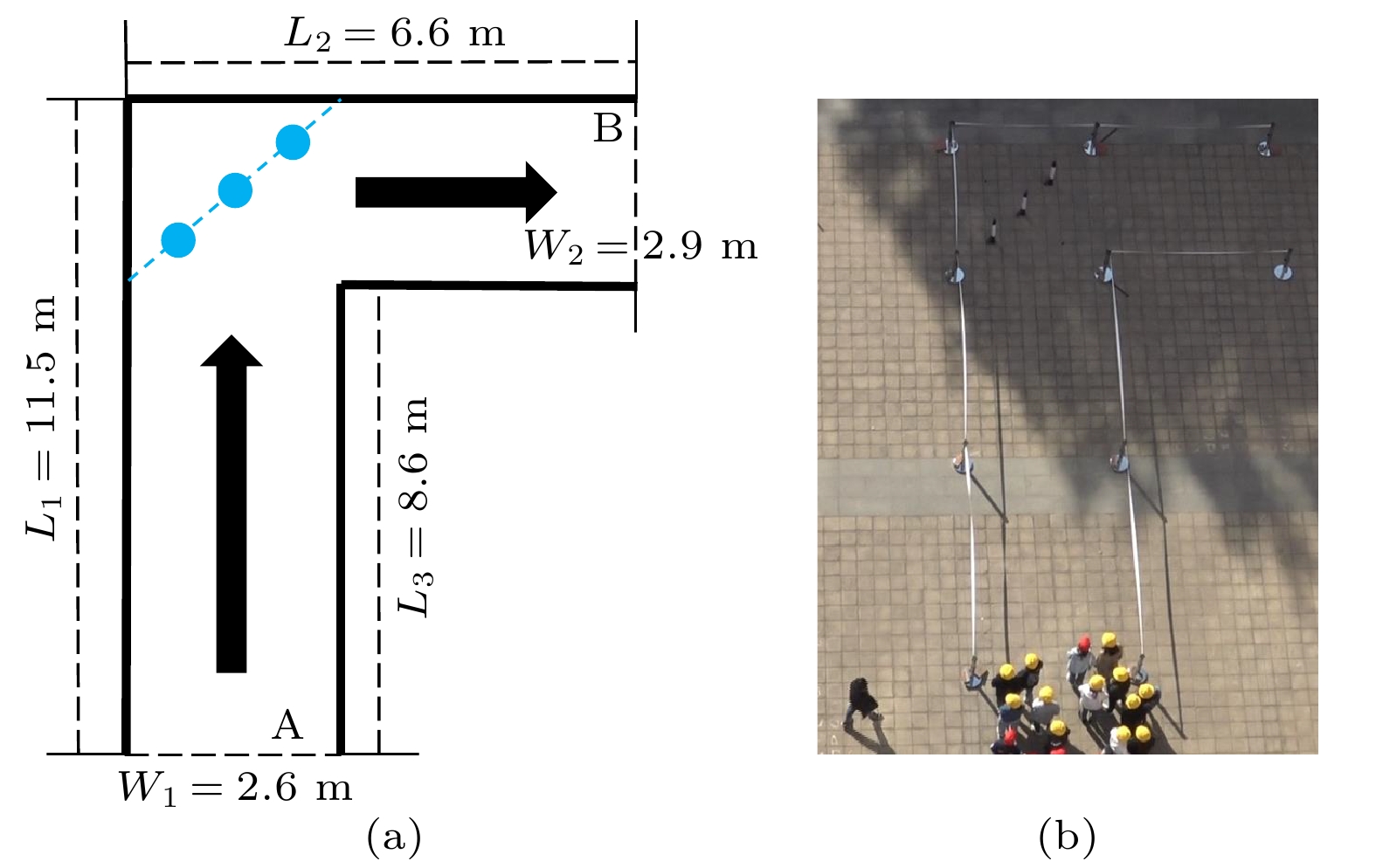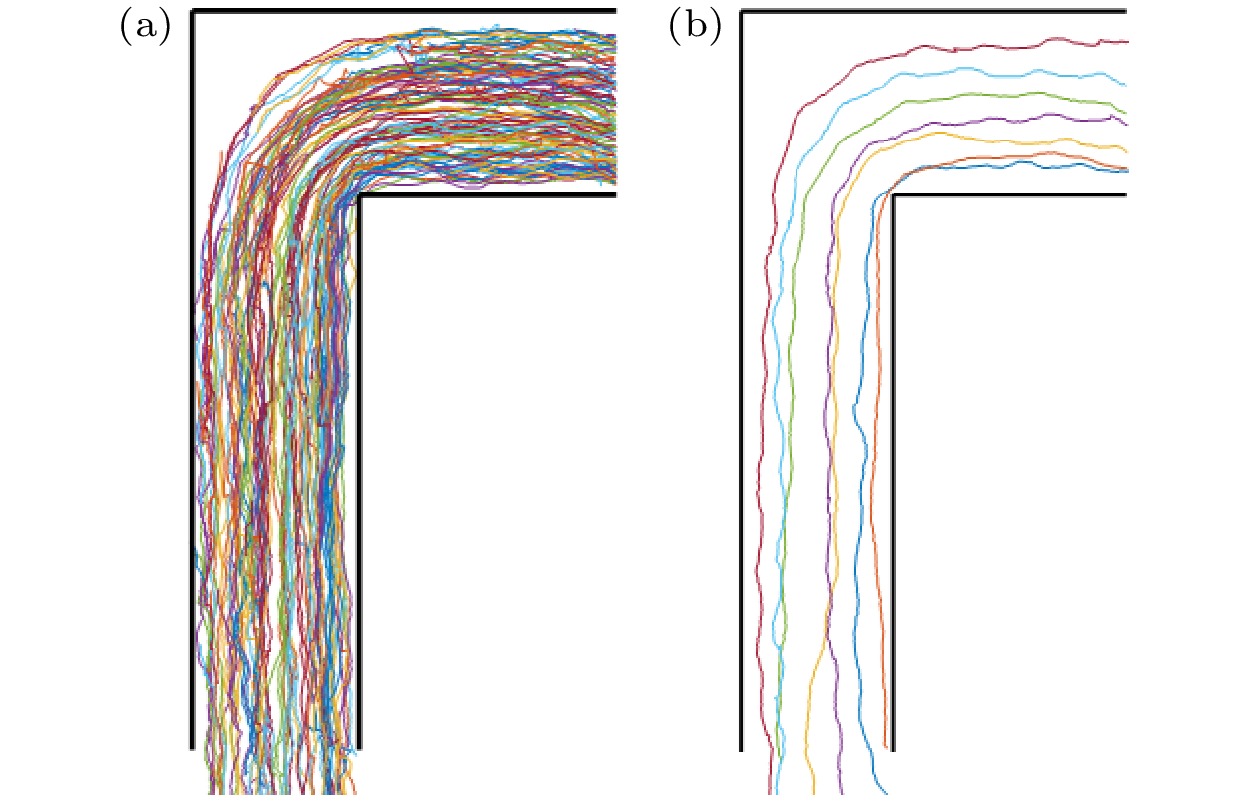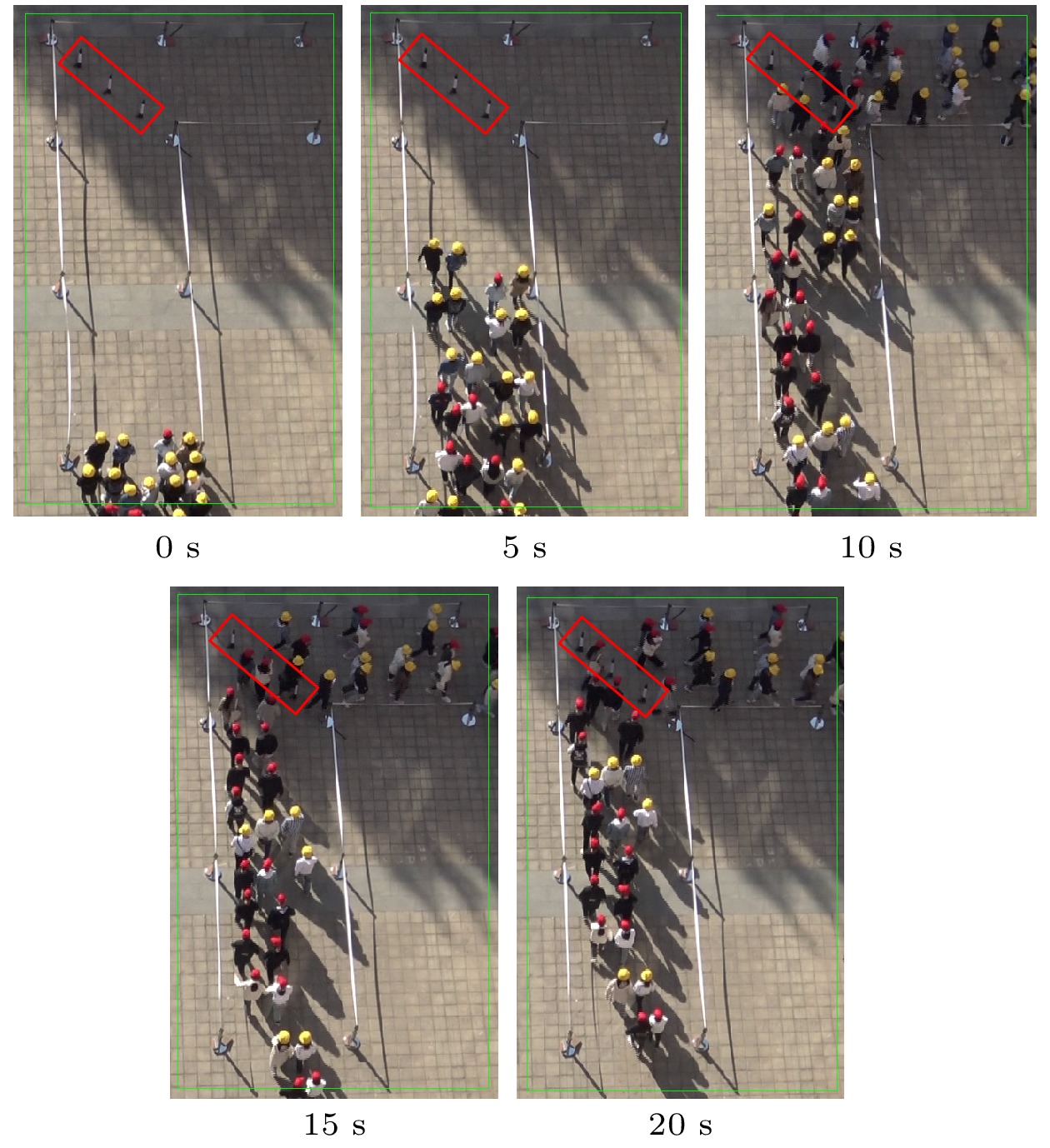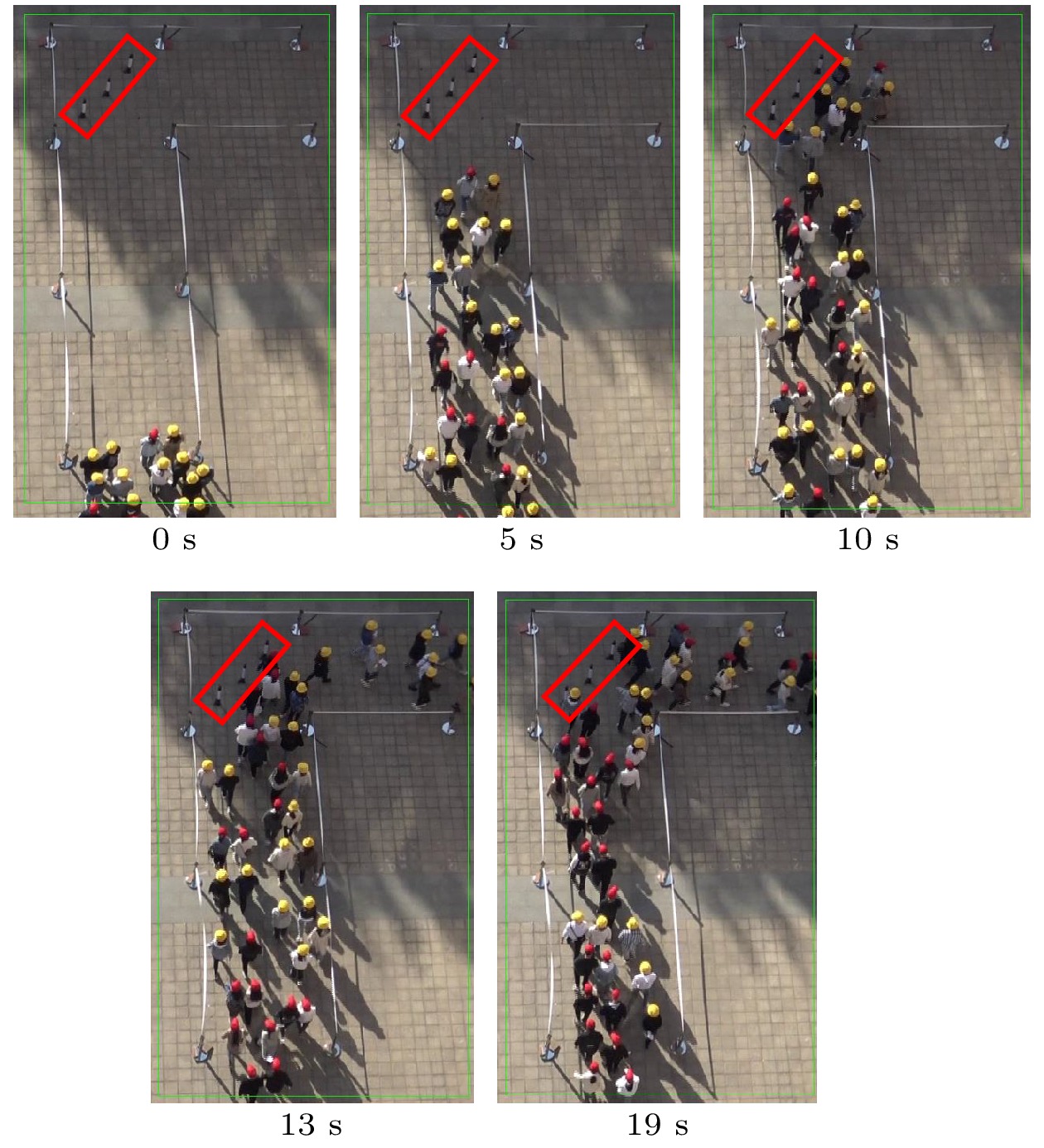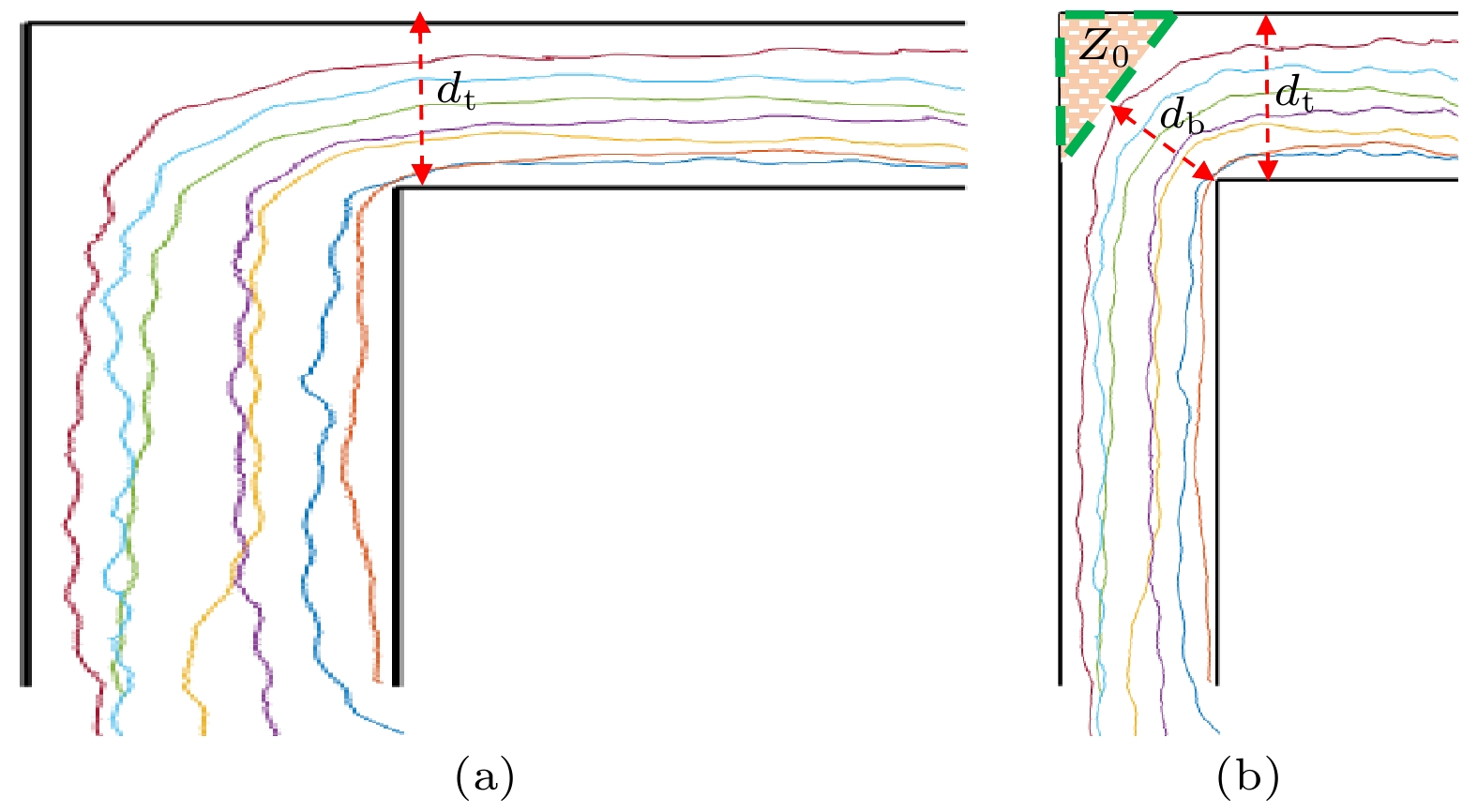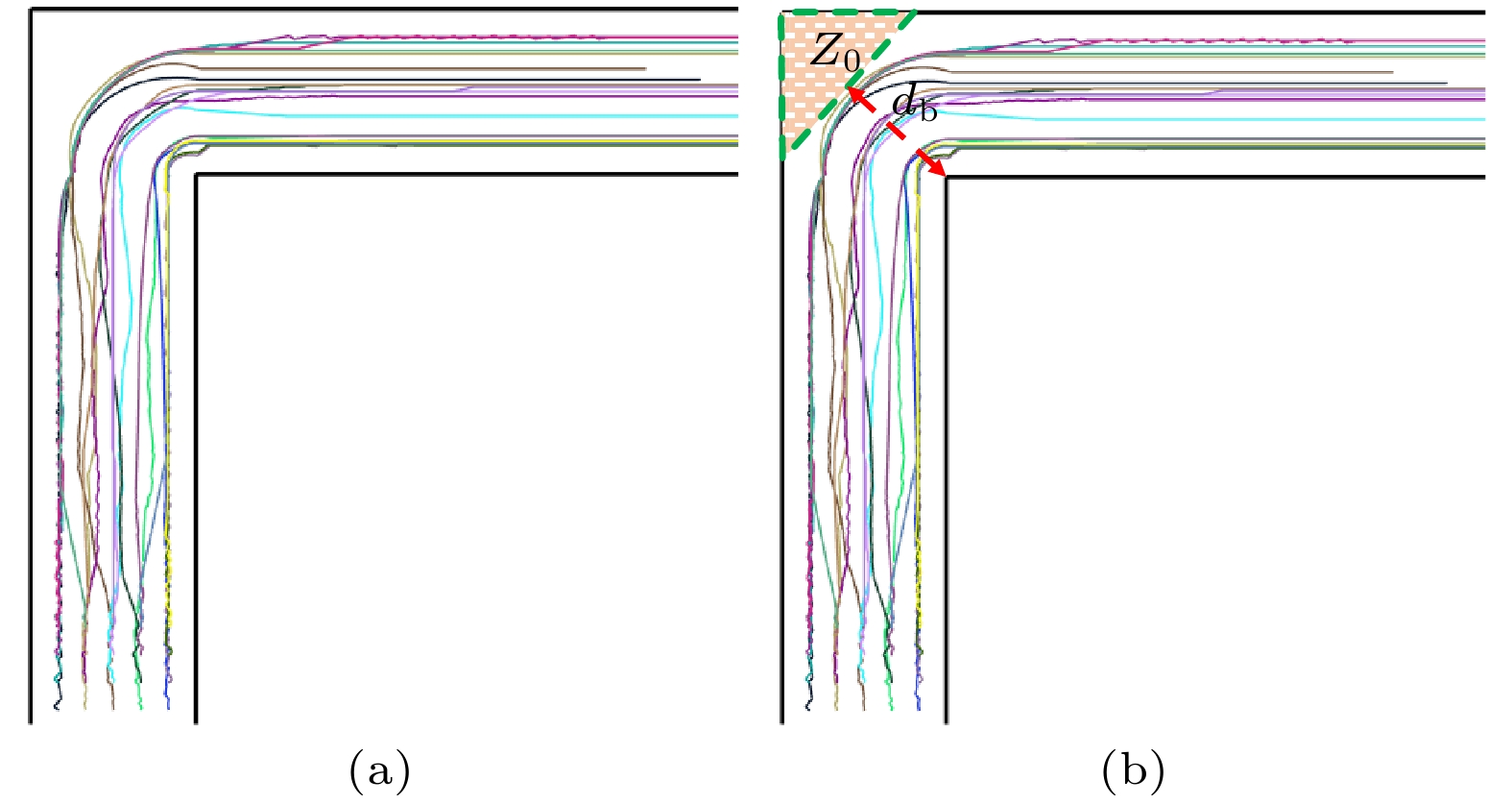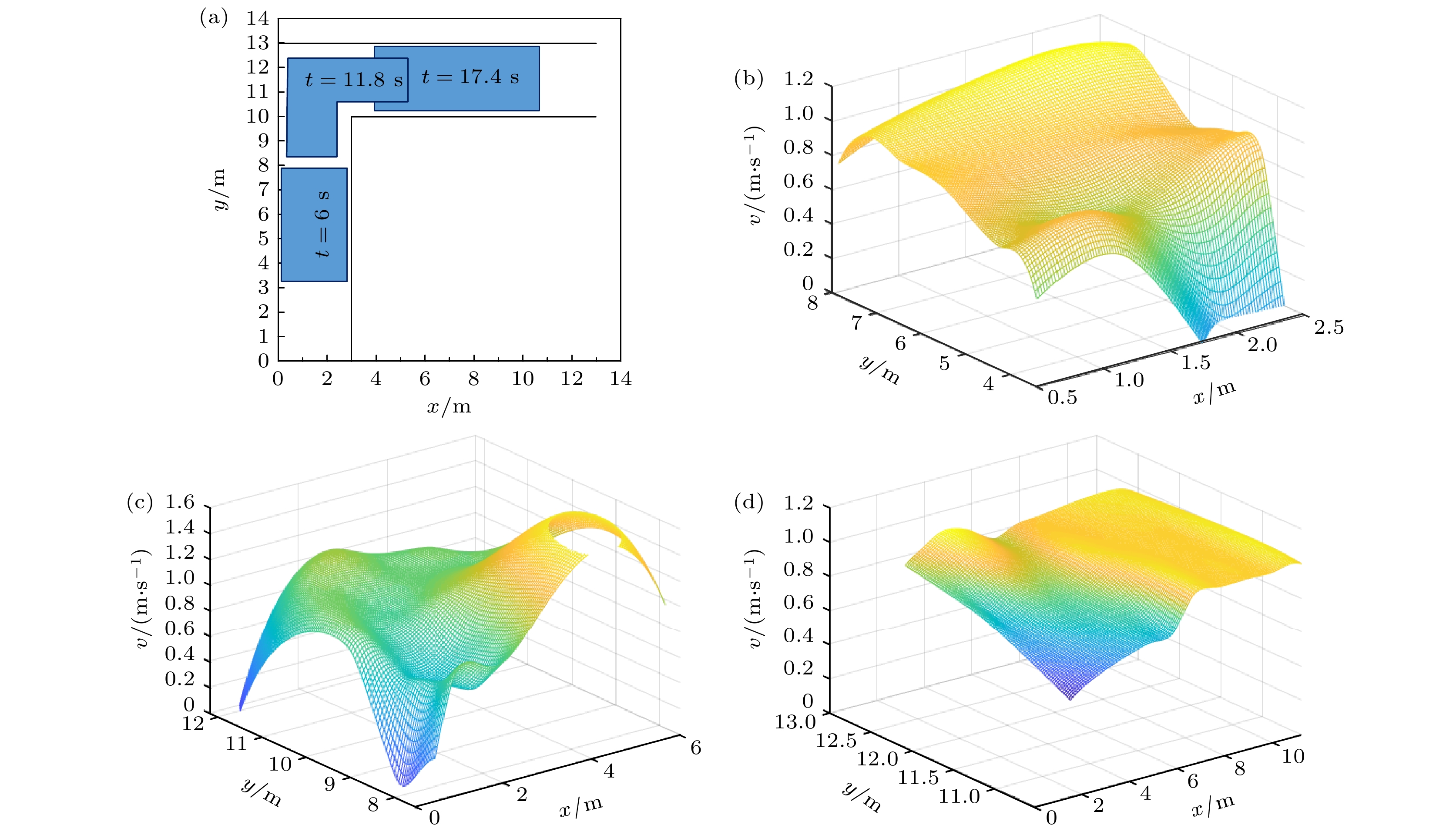-
以L型步行通道内的单向行人流为研究对象, 基于可控实验与微观仿真研究行人转弯行为. 首先, 构建转弯区无障碍物、障碍物沿转弯区对角线布局、以及障碍物垂直转弯区对角线布局三种实验场景, 通过行人可控实验分析行人移动轨迹、速度分布等行为特征; 然后, 基于L型通道内的行人微观行为, 改进基于Voronoi图的速度修正仿真模型, 制定并嵌入行人通过L型通道的转弯规则; 最后, 分别对有/无障碍物以及非对称L型通道场景进行仿真研究, 模拟再现行人的转弯行为, 分析研究不同阶段行人速度与个体密度的分布情况. 研究发现: 基于行人的移动行为, L型通道可分为垂直直行区域、过渡区域、转弯区域和水平直行区域; 行人在通过转弯区域时会形成“隐形瓶颈”和“弯道三角形闲置区域”, 产生一定的流线压缩; 改进的仿真模型, 可以模拟再现行人通过弯道区域时呈现光滑弧线的移动轨迹, 并能观察到“隐形瓶颈”和“弯道三角形闲置区域”现象; 同时, 行人流依次通过L型通道的四个区域时, 其速度分布情况与行人实验数据相吻合, 呈现先增后减再增“波浪式”变化的特点. 该仿真模型也模拟再现了由于转弯行为导致行人局部密度变化的情况, 彼此印证了行人速度与局部密度变化的统一性. 对“隐形瓶颈”的认知, 有助于合理利用和设计L型通道转弯区域.In our study, the unidirectional pedestrian flow in an L-shaped corridor is taken as the research object, and the pedestrian turning behavior is studied based on controllable experiments and micro simulations. First of all, three experimental scenarios, namely, no obstacles in the turning zone, diagonal layout of obstacles along the turning zone, and diagonal layout of obstacles in the vertical turning zone, are constructed. Behavioral characteristics such as pedestrian movement trajectory and velocity distribution are analyzed through controllable experiments of pedestrians. Then, a velocity correction model based on the Voronoi diagram is constructed, and the turning rules of pedestrians passing through a 90-degree L-shaped curve are embedded in the model. Finally, simulation research is conducted on the scene with both obstacles and asymmetric L-shaped corridors as well as the scene with neither of them to simulate and reproduce the turning behavior of pedestrians, and analyze the distributions of pedestrian velocities and individual densities at different stages. The research shows that when pedestrians move in a normal non-panic status, they rarely present disorderly behavior and always approach to the inside of the corner of the L-shaped corridor. In the turning area, pedestrians always follow their original moving mode to pass through the corner like a stable arc. And in the process of moving, pedestrians do not move in a straight line, but keep shaking back and forth for zipper effect. Besides, in the process of turning, the longer the distance from the center of the corner, the longer the distance of the pedestrian around the arc will be. And the L-shaped corridor can be divided into vertical straight area, transition area, turning area, and horizontal straight area. When pedestrians pass through the turning walking area, the “invisible bottleneck” phenomenon and the “curved triangle idle area” phenomenon can be observed. Besides, the streamline compression and multiple rows of pedestrian track clusters can be seen in the region. According to the characteristics of pedestrians walking through the L-shaped corridor, the turning rules of pedestrians are made, and the scene with both of obstacles and asymmetric L-shaped corridor as well as the scene with neither of them is simulated. Then, through the pedestrian simulation by using our model, the turning behavior of pedestrians passing through curve like a smooth arc can be effectively reproduced. Moreover, the “invisible bottleneck” phenomenon and the “curved triangle idle area” phenomenon in the turning walking area can be seen in the simulation. At the same time, when the pedestrian flow passes through the four areas of the L-shaped corridor successively, the velocity distribution is consistent with the experimental data of the pedestrian, showing an increasing-decreasing-increasing “wavy” change characteristic. The simulation model is also used to simulate the local density change of pedestrians due to the turning behavior, which verifies the unity of pedestrian velocity and local density change. The cognition of invisible bottleneck is helpful in rationally utilizing and designing the L-shaped corridor turning area.
-
Keywords:
- pedestrian dynamics /
- L-shaped corridor /
- velocity correction model /
- Voronoi diagram /
- invisible bottleneck
[1] Shiwakoti N, Sarvi M, Rose G, Burd M 2011 Transp. Res. Rec. 2234 97
 Google Scholar
Google Scholar
[2] Dias C, Sarvi M, Shiwakoti N, Ejtemai O, Burd M 2013 Saf. Sci. 60 87
 Google Scholar
Google Scholar
[3] Shiwakoti N, Sarvi M 2013 Transp. Res. Part C Emerg. Technol. 37 260
 Google Scholar
Google Scholar
[4] G uo, R Y, Huang H J, Wong S C 2011 Transp. Res. Part. B Methodol. 45 490
 Google Scholar
Google Scholar
[5] Xiao Y, Gao Z Y, Jiang R, Li X G, Qu Y C, Huang Q X 2019 Transp. Res. Part C Emerg. Technol. 103 174
 Google Scholar
Google Scholar
[6] Blue V J, Adler J L 2000 Transp Res Rec. 1710 20
 Google Scholar
Google Scholar
[7] Yue H, Wang S, Jia X L, Li J, Shao C F 2016 Simul. Trans. Soc. Model. Simul. Int. 92 491
[8] Burstedde C, Klauck K, Schadschneider A, Zittartz J 2001 Physica A 295 507
 Google Scholar
Google Scholar
[9] Helbing D, Farkas I, Vicsek T 2000 Nature 407 487
 Google Scholar
Google Scholar
[10] Moussaid M, Helbing D, Garnier S, Johansson A, Combe M, Theraulaz G 2009 Proc. R. Soc. B: Biol. Sci. 276 2755
 Google Scholar
Google Scholar
[11] Moussaid M, Helbing D, Theraulaz G 2011 Proc. Natl. Acad. Sci. U.S.A. 108 6884
 Google Scholar
Google Scholar
[12] Qu Y C, Xiao Y, Wu J J, Tang T, Gao Z Y 2018 Physica A 492 1153
 Google Scholar
Google Scholar
[13] Wu X S, Yue H, Liu Q M, Zhang X, Shao C F 2021 Chin. Phys. B 30 018902
 Google Scholar
Google Scholar
[14] Haghani M, Sarvi M 2018 Transp. Res. Part B Methodol. 107 253
 Google Scholar
Google Scholar
[15] Frank G A, Dorso C O 2011 Physica A 390 2135
 Google Scholar
Google Scholar
[16] Seyfried A, Steffen B, Lippert T 2006 Physica A 368 232
 Google Scholar
Google Scholar
[17] Dias C, Ejtemai O, Sarvi M, Shiwakoti N 2014 Transp. Res. Rec. 2421 41
 Google Scholar
Google Scholar
[18] Hou L, Liu J G, Pan X, Wang B H 2014 Physica A 400 93
 Google Scholar
Google Scholar
[19] Seer S, Brandle N, Ratti C 2014 Transp. Res. Part C Emerg. Technol. 48 212
 Google Scholar
Google Scholar
[20] Ma X Q, Yin X Y, Xing Y, Liu Y F 2017 In Proceedings of the 3rd International Forum on Energy. Environment Science and Materials (IFEESM) Shenzhen, China, November 25−26, 2017 p154
[21] 武鑫森, 岳昊, 刘秋梅, 张旭, 邵春福 2021 70 068901
 Google Scholar
Google Scholar
Wu X S, Yue H, Liu Q M, Zhang X, Shao C F 2021 Acta Phys. Sin. 70 068901
 Google Scholar
Google Scholar
[22] Schadschneider A, Eilhardt C, Nowak S, Will R 2011 International Conference on Pedestrian and Evacuation Dynamics 2010 Gaithersburg, USA, March 8−10, 2010 p557
[23] Li S, Li X, Qu Y, Jia B 2015 Physica A 432 337
 Google Scholar
Google Scholar
[24] Dias C, Lovreglio R 2018 Phys. Lett. A 382 1255
 Google Scholar
Google Scholar
[25] Yanagisawa D, Kimura A, Tomoeda A, Nishi R, Suma Y, Ohtsuka K, Nishinari K 2009 Phys. Rev. E 80 036110
 Google Scholar
Google Scholar
[26] Dias C, Abdullah M, Sarvi M, Lovreglio R, Alhajyaseen W 2019 Sustainability 11 5501
 Google Scholar
Google Scholar
[27] Zeng J B, Leng B, Xiong Z 2011 Int. J. Mod. Phys. C 22 775
 Google Scholar
Google Scholar
[28] Guo R Y, Tang T Q 2012 Simul. Modell. Pract. Theory 21 103
 Google Scholar
Google Scholar
[29] Jing L, Li J Y, Shen C, Yang S C, Han Z G 2014 PLoS One 9 e115463
 Google Scholar
Google Scholar
[30] Parisi D R, Negri P A, Bruno L 2016 Phys. Rev. E 94 022318
[31] Boltes M, Seyfried A, Steffen B, Schadschneider A 2010 International Conference on Pedestrian and Evacuation Dynamics 2008, Heidelberg, Germany, February 27−29, 2008 p43
[32] Boltes M, Seyfried A 2013 Neurocomputing 100 127
 Google Scholar
Google Scholar
[33] Hoogendoorm S P, Daamen W 2005 Transp. Sci. 39 147
 Google Scholar
Google Scholar
[34] Cao S C, Zhang J, Song W G, Shi C A, Zhang R F 2018 J. Stat. Mech.: Theory Exp. 3 033402
[35] Courtine G, Schieppati M 2003 Eur. J. Neurosci. 18 177
 Google Scholar
Google Scholar
[36] Hicheur H, Vieilledent S, Richardson M J E, Flash T, Berthoz A 2005 Exp. Brain Res. 162 145
 Google Scholar
Google Scholar
[37] Imai T, Moore S T, Raphan T, Cohen B 2001 Exp. Brain Res. 136 1
 Google Scholar
Google Scholar
[38] Illera C, Fink M, Hinneberg H, Kath K, Waldau N, Rosic A, Wurzer G 2010 International Conference on Pedestrian and Evacuation Dynamics 2008. Heidelberg, Germany, February 27−29, 2008 p733
[39] Shiwakoti N, Gong Y S, Shi X M, Ye Z R 2015 Saf. Sci. 75 15
 Google Scholar
Google Scholar
[40] Kirik E, Vitova T, Malyshev A 2019 Nat. Comput. 18 875
 Google Scholar
Google Scholar
-
图 8 行人在场景1无障碍物的L型通道移动的特征分析 (a) 行人在通道移动的四区域; (b) 行人在转弯区域的转弯特征; (c) 行人在通道移动的隐形瓶颈
Fig. 8. Analysis on the characteristics of pedestrian movement in an L-shaped corridor without obstacles in Scene 1: (a) Four types of areas where pedestrians move in the corridor; (b) the turning characteristics of pedestrians in the turning area; (c) the invisible bottleneck of pedestrian movement in the corridor.
图 14 不同场景的弯道三角形闲置区域面积大小对比 (a) 场景1的弯道三角形闲置区域面积; (b) 场景2的弯道三角形闲置区域面积; (c) 场景3的弯道三角形闲置区域面积
Fig. 14. Comparisons of the area size of the curve triangle idle area in different scenes: (a) The area size of the curve triangle idle area in Scene 1; (b) the area size of the curve triangle idle area in Scene 2; (c) the area size of the curve triangle idle area in Scene 3
图 20 行人通过L型无障碍物通道的仿真过程(
$ {W_1} = 3\;{\rm{m}}$ ,$ {L_1} = 13\;{\rm{m}}$ ,$ {W_2} = 3\;{\rm{m}}$ ,$ {L_2} = 10\;{\rm{m}}$ ) (a) t = 0 s; (b) t = 6.0 s; (c) t = 11.8 s; (d) t = 17.4 s; (e) t = 21.2 sFig. 20. The screenshots of the simulation process of pedestrians passing through the L-shaped corridor without obstacles (
${W_1} = 3\;{\rm{m}}$ ,${L_1} = 13\;{\rm{m}}$ ,${W_2} = 3\;{\rm{m}}$ ,${L_2} = 10\;{\rm{m}}$ ).: (a) t = 0 s; (b) t = 6.0 s; (c) t = 11.8 s; (d) t = 17.4 s; (e) t = 21.2 s.图 22 L型无障碍通道内不同时刻行人速度分布情况 (a) L型无障碍物通道位置与直角坐标系的对应关系; (b) 行人在垂直直行区域的速度, t = 6.0 s; (c) 行人在过渡及转弯区域的速度, t = 11.8 s; (d) 行人在水平直行区域的速度, t = 17.4 s
Fig. 22. The velocity distribution of pedestrians at different times in L-shaped corridor without obstacles: (a) Corresponding relation between the position of L-shaped straight corridor without obstacles and Cartesian coordinate system; (b) the velocity of pedestrians in vertical straight-ahead areas, t = 6.0 s; (c) the velocity of pedestrians in transition and turning areas, t = 11.8 s; (d) the velocity of pedestrians in horizontal straight-ahead areas, t = 17.4 s.
图 23 L型无障碍通道行人个体局部密度的变化情况 (a) 行人在垂直直行区域的个体局部密度, t = 6.0 s; (b) 行人在过渡及转弯区域的个体局部密度, t = 11.8 s; (c) 行人在水平直行区域的个体局部密度, t = 17.4 s
Fig. 23. The variation trend of the individual local density of pedestrians in L-shaped straight corridor without obstacles: (a) The individual local density of pedestrians in vertical straight-ahead areas, t = 6.0 s; (b) the individual local density of pedestrians in transition and turning areas, t = 11.8 s; (c) the individual local density of pedestrians in horizontal straight-ahead areas, t = 17.4 s.
图 24 行人通过L型有障碍通道的仿真过程(
$ {W_1} = 3\;{\rm{m}}$ ,$ {L_1} = 13\;{\rm{m}}$ ,$ {W_2} = 3\;{\rm{m}}$ ,$ {L_2} = 10\;{\rm{m}}$ ) (a) t = 7.4 s; (b) t = 9.3 s; (c) t = 11.0 s; (d) t = 13.5 sFig. 24. The screenshots of the simulation process of pedestrians passing through the L-shaped corridor with obstacles (
$ {W_1} = 3\;{\rm{m}}$ ,${L_1} = 13\;{\rm{m}}$ ,$ {W_2} = 3\;{\rm{m}}$ ,$ {L_2} = 10\;{\rm{m}}$ ): (a) t = 7.4 s; (b) t = 9.3 s; (c) t = 11.0 s; (d) t = 13.5 s图 25 L型有障碍通道行人速度的变化趋势 (a) L型有障碍通道位置与直角坐标系的对应关系; (b) 行人接近转弯区域的速度, t = 7.4 s; (c) 行人刚进入转弯区域的速度, t = 9.3 s; (d)行人部分处于转弯区域的速度, t = 11.0 s; (e) 行人大部分通过转弯区域的速度, t = 13.5 s
Fig. 25. The variation trend of pedestrian velocity in L-shaped corridor with obstacles: (a) Corresponding relation between the position of L-shaped corridor with obstacles and Cartesian coordinate system; (b) the velocity at which pedestrians approach the turning area, t = 7.4 s; (c) the velocity at which the pedestrians first enter the turning area, t = 9.3 s; (d) the velocity at which the pedestrians part are in the turning area, t = 11.0 s; (e) the velocity at which the pedestrians pass through the turning area for the most part, t = 13.5 s.
图 26 L型有障碍通道行人个体局部密度的分布情况 (a) 行人接近转弯区域的个体局部密度, t = 7.4 s; (b) 行人刚进入转弯区域的个体局部密度, t = 9.3 s; (c) 行人部分处于转弯区域的个体局部密度, t = 11.0 s; (d) 行人大部分通过转弯区域的个体局部密度, t = 13.5 s
Fig. 26. The individual local density distribution of pedestrians in L-shaped corridor with obstacles: (a) The individual local density at which pedestrians approach the turning area, t = 7.4 s; (b) the individual local density at which the pedestrians first enter the turning area, t = 9.3 s; (c) the individual local density at which the pedestrians part are in the turning area, t = 11.0 s; (d) the individual local density at which the pedestrians pass through the turning area for the most part, t = 13.5 s.
图 27 行人通过非对称L型通道的仿真过程(
${W_1} = 6\;{\rm{m}}$ ,${L_1} = 12\;{\rm{m}}$ ,${W_2} = 2\;{\rm{m}}$ ,${L_2} = 10\;{\rm{m}}$ ) (a) t = 0.2 s; (b) t = 4.5 s; (c) t = 12.5 s; (d) t = 204 sFig. 27. The screenshots of the simulation process of pedestrians passing through an asymmetric L-shaped corridor (
${W_1} = 6\;{\rm{m}}$ ,${L_1} = 12\;{\rm{m}}$ ,${W_2} = 2\;{\rm{m}}$ ,${L_2} = 10\;{\rm{m}}$ ): (a) t = 0.2 s; (b) t = 4.5 s; (c) t = 12.5 s; (d) t = 204 s.参数 取值 单位 参数 取值 ${v_0}$ 1 ${\rm{m}}/{\rm{s}}$ ${k_1}$ 1.0 ${r_i}$ 0.3 m ${k_2}$ 0.6 ${d_{{\rm{m}}1}}$ 0 m ${k_3}$ 0.2 ${d_{{\rm{m}}2}}$ 0.5 m ${k_4}$ 0 ${d_{{\rm{m}}3}}$ 0.25 m ${k_5}$ 0.8 $\Delta t$ 0.5 s ${k_6}$ 0 -
[1] Shiwakoti N, Sarvi M, Rose G, Burd M 2011 Transp. Res. Rec. 2234 97
 Google Scholar
Google Scholar
[2] Dias C, Sarvi M, Shiwakoti N, Ejtemai O, Burd M 2013 Saf. Sci. 60 87
 Google Scholar
Google Scholar
[3] Shiwakoti N, Sarvi M 2013 Transp. Res. Part C Emerg. Technol. 37 260
 Google Scholar
Google Scholar
[4] G uo, R Y, Huang H J, Wong S C 2011 Transp. Res. Part. B Methodol. 45 490
 Google Scholar
Google Scholar
[5] Xiao Y, Gao Z Y, Jiang R, Li X G, Qu Y C, Huang Q X 2019 Transp. Res. Part C Emerg. Technol. 103 174
 Google Scholar
Google Scholar
[6] Blue V J, Adler J L 2000 Transp Res Rec. 1710 20
 Google Scholar
Google Scholar
[7] Yue H, Wang S, Jia X L, Li J, Shao C F 2016 Simul. Trans. Soc. Model. Simul. Int. 92 491
[8] Burstedde C, Klauck K, Schadschneider A, Zittartz J 2001 Physica A 295 507
 Google Scholar
Google Scholar
[9] Helbing D, Farkas I, Vicsek T 2000 Nature 407 487
 Google Scholar
Google Scholar
[10] Moussaid M, Helbing D, Garnier S, Johansson A, Combe M, Theraulaz G 2009 Proc. R. Soc. B: Biol. Sci. 276 2755
 Google Scholar
Google Scholar
[11] Moussaid M, Helbing D, Theraulaz G 2011 Proc. Natl. Acad. Sci. U.S.A. 108 6884
 Google Scholar
Google Scholar
[12] Qu Y C, Xiao Y, Wu J J, Tang T, Gao Z Y 2018 Physica A 492 1153
 Google Scholar
Google Scholar
[13] Wu X S, Yue H, Liu Q M, Zhang X, Shao C F 2021 Chin. Phys. B 30 018902
 Google Scholar
Google Scholar
[14] Haghani M, Sarvi M 2018 Transp. Res. Part B Methodol. 107 253
 Google Scholar
Google Scholar
[15] Frank G A, Dorso C O 2011 Physica A 390 2135
 Google Scholar
Google Scholar
[16] Seyfried A, Steffen B, Lippert T 2006 Physica A 368 232
 Google Scholar
Google Scholar
[17] Dias C, Ejtemai O, Sarvi M, Shiwakoti N 2014 Transp. Res. Rec. 2421 41
 Google Scholar
Google Scholar
[18] Hou L, Liu J G, Pan X, Wang B H 2014 Physica A 400 93
 Google Scholar
Google Scholar
[19] Seer S, Brandle N, Ratti C 2014 Transp. Res. Part C Emerg. Technol. 48 212
 Google Scholar
Google Scholar
[20] Ma X Q, Yin X Y, Xing Y, Liu Y F 2017 In Proceedings of the 3rd International Forum on Energy. Environment Science and Materials (IFEESM) Shenzhen, China, November 25−26, 2017 p154
[21] 武鑫森, 岳昊, 刘秋梅, 张旭, 邵春福 2021 70 068901
 Google Scholar
Google Scholar
Wu X S, Yue H, Liu Q M, Zhang X, Shao C F 2021 Acta Phys. Sin. 70 068901
 Google Scholar
Google Scholar
[22] Schadschneider A, Eilhardt C, Nowak S, Will R 2011 International Conference on Pedestrian and Evacuation Dynamics 2010 Gaithersburg, USA, March 8−10, 2010 p557
[23] Li S, Li X, Qu Y, Jia B 2015 Physica A 432 337
 Google Scholar
Google Scholar
[24] Dias C, Lovreglio R 2018 Phys. Lett. A 382 1255
 Google Scholar
Google Scholar
[25] Yanagisawa D, Kimura A, Tomoeda A, Nishi R, Suma Y, Ohtsuka K, Nishinari K 2009 Phys. Rev. E 80 036110
 Google Scholar
Google Scholar
[26] Dias C, Abdullah M, Sarvi M, Lovreglio R, Alhajyaseen W 2019 Sustainability 11 5501
 Google Scholar
Google Scholar
[27] Zeng J B, Leng B, Xiong Z 2011 Int. J. Mod. Phys. C 22 775
 Google Scholar
Google Scholar
[28] Guo R Y, Tang T Q 2012 Simul. Modell. Pract. Theory 21 103
 Google Scholar
Google Scholar
[29] Jing L, Li J Y, Shen C, Yang S C, Han Z G 2014 PLoS One 9 e115463
 Google Scholar
Google Scholar
[30] Parisi D R, Negri P A, Bruno L 2016 Phys. Rev. E 94 022318
[31] Boltes M, Seyfried A, Steffen B, Schadschneider A 2010 International Conference on Pedestrian and Evacuation Dynamics 2008, Heidelberg, Germany, February 27−29, 2008 p43
[32] Boltes M, Seyfried A 2013 Neurocomputing 100 127
 Google Scholar
Google Scholar
[33] Hoogendoorm S P, Daamen W 2005 Transp. Sci. 39 147
 Google Scholar
Google Scholar
[34] Cao S C, Zhang J, Song W G, Shi C A, Zhang R F 2018 J. Stat. Mech.: Theory Exp. 3 033402
[35] Courtine G, Schieppati M 2003 Eur. J. Neurosci. 18 177
 Google Scholar
Google Scholar
[36] Hicheur H, Vieilledent S, Richardson M J E, Flash T, Berthoz A 2005 Exp. Brain Res. 162 145
 Google Scholar
Google Scholar
[37] Imai T, Moore S T, Raphan T, Cohen B 2001 Exp. Brain Res. 136 1
 Google Scholar
Google Scholar
[38] Illera C, Fink M, Hinneberg H, Kath K, Waldau N, Rosic A, Wurzer G 2010 International Conference on Pedestrian and Evacuation Dynamics 2008. Heidelberg, Germany, February 27−29, 2008 p733
[39] Shiwakoti N, Gong Y S, Shi X M, Ye Z R 2015 Saf. Sci. 75 15
 Google Scholar
Google Scholar
[40] Kirik E, Vitova T, Malyshev A 2019 Nat. Comput. 18 875
 Google Scholar
Google Scholar
计量
- 文章访问数: 6638
- PDF下载量: 106
- 被引次数: 0














 下载:
下载:


